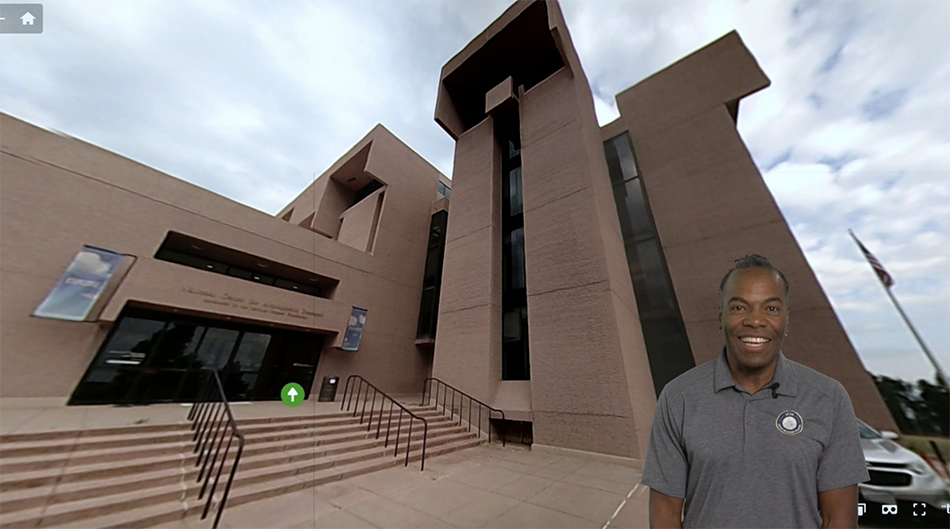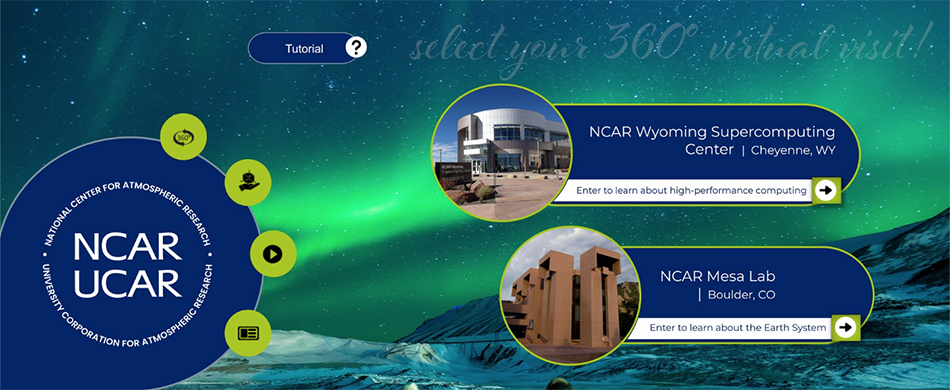Beyond Boulder: NCAR’s virtual tours allow a broader audience to experience its exhibits
Anyone can experience the wonder of the Mesa Lab and supercomputing facility from afar
Dec 12, 2022 - by Laura Snider
Dec 12, 2022 - by Laura Snider

Science educator Tim Barnes leads a virtual tour at the Mesa Lab. Anyone can sign up to be a part of a guided virtual tour or explore using the 360 app on their own. (Image: SciEd)
Long touted as a top activity for visitors to the Boulder, Colorado, area, the weather and climate exhibits at the National Center for Atmospheric Research (NCAR) typically drew tens of thousands of people a year before the COVID-19 pandemic forced the exhibits to close.
The closures, however, came with a silver lining. The pandemic gave staff at the University Corporation for Atmospheric Research (UCAR) Center for Science Education (SciEd) the time and additional motivation to create a virtual tour web app that allows anyone from anywhere to experience the excitement of NCAR, both at the iconic Mesa Lab in Boulder and at the NCAR-Wyoming Supercomputing Center (NWSC) in Cheyenne, in a 360-degree virtual environment.
While the in-person exhibits at the Mesa Lab recently reopened to the public, the virtual tour apps remain an important priority for the SciEd team. Since the apps were launched, SciEd continues to add new content and is currently working on the ability for virtual guests to take a “stroll” on the breathtaking Walter Orr Roberts interpretive weather trail that sits behind the Mesa Lab, a feature they plan to launch in the spring. Now, UCAR SciEd is seeking feedback on the virtual tours through a survey of app users.
“We’re trying to figure out what content people like best,” said Katie Wolfson, SciEd’s School and Public Programs Manager. “Should we add more videos? More augmented reality? Which features are the most engaging?”

The physical exhibits at the Mesa Lab have long allowed in-person visitors to get a taste for vital science being undertaken at NCAR. Exhibit areas focus on weather, climate, and the Sun-Earth connection, as well as providing an inside look at NCAR-facilitated airborne field campaigns and the history of the lab’s unique architecture. The physical exhibits at the NWSC highlight the vast power of supercomputing and its importance for investigating the complex connections in the Earth system.
In the virtual tour app, visitors can move through all of the exhibits at both locations. While they can’t interact physically with the displays, the rich content offered online gives them a unique experience, in some cases above and beyond what can be seen in person. For example, virtual visitors can rotate and spin objects that in-person visitors can only see mounted in a fixed position. This includes a dropsonde — an instrument dropped into hurricanes to collect data used to improve storm forecast — and a satellite that collects atmospheric data by measuring the bend in GPS signal.
Visitors can also tune into a webcast and take a virtual tour led by Wolfson and her SciEd colleague Tim Barnes. Hundreds of people have participated in the facilitated virtual tours, which are part of a broader slate of virtual offerings that include Meet the Experts Q&A sessions with scientists and virtual field trips for K-12 groups. Since the pandemic began, these live virtual programs have reached 37 states and 13 countries.
“Our virtual strategy has allowed us to continue to engage the public and actually reach more people in more places,” said Emily Snode-Brenneman, a member of the SciEd team. “We are excited to have re-opened our Boulder-based exhibits to the public, but we have no plans to stop our virtual programming. In fact, we plan to keep expanding the content so people from all over have the opportunity to experience NCAR.”
Anyone can sign up for a public tour, private group tour, or virtual field trip on the SciEd website.
Take the survey!
Once you’ve had a chance to explore the virtual tour, let us know what you think! Look “down” towards your feet for a link to the survey (or go directly there) and share your thoughts!